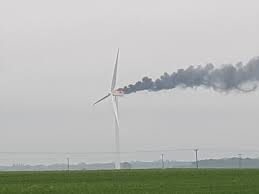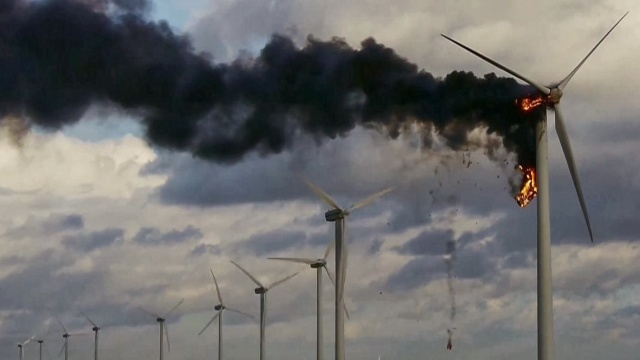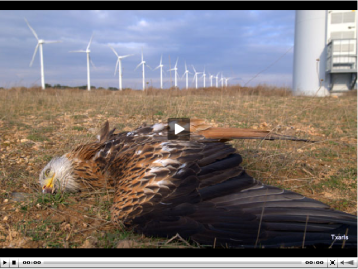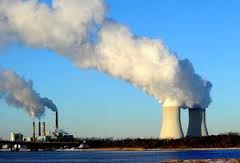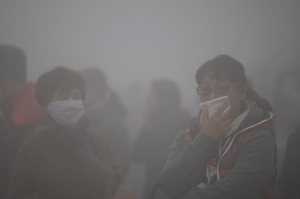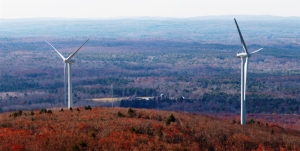[Editor’s Note: Dr. Pierpont is the author of a landmark study on the health effects from exposure to the low frequency noise emitted by industrial wind turbines, entitled “Wind Turbine Syndrome: A Report on a Natural Experiment” published in 2009.]
NINA PIERPONT M.D. Ph.D.
ISO acknowledges motion sickness from low-frequency oscillatory
motion below 1 Hz
Noise engineer Richard James just sent to me the attached section of a
standards statement by the International Standards Organization (ISO)
regarding exposure to low-frequency oscillatory motion, of which I consider the
air pressure pulsations produced by wind turbines to be a subset. I have
generally called these low-frequency air pressure pulsations infrasound, since
sound waves in air are rhythmic or oscillatory variations in air pressure. At
higher frequencies these oscillatory variations in air pressure are perceived as
sound. Infrasound means “below the range of human hearing.”
(If you’re not familiar with the ISO, it is the global authority setting all manner of
industrial standards, including noise standards. Click here for a more thorough
explanation of what the ISO does.)
Since it is well established that IWT’s (Industrial Wind Turbines) produce pulsed infrasound below 1 Hz, this suggests that people around the world who
experience motion sickness from wind turbines are not “making it up.” They
are not fabricating these symptoms. Their symptoms are not Simon Chapman’s
silly “nocebo effect.” The symptoms are — real! Really and truly caused by
IWT infrasound.
With this being common knowledge, why, then, have these symptoms been
denied in those experiencing them in proximity to wind turbines and directly
correlated with wind turbine function?
Since it is well established that IWT’s (Industrial Wind Turbines) produce pulsed infrasound below 1 Hz, this suggests that people around the world who experience motion sickness from wind turbines are not “making it up.” They are not fabricating these symptoms. Their symptoms are not Simon Chapman’s silly “nocebo effect.” The symptoms are — real! Really and truly caused by IWT infrasound.
Mr. James cites the following passages from the current ISO manual, ISO
9996:1996 “Mechanical vibration and shock — Disturbance to human activity
and performance — Classification.” Notice the passages highlighted in red
and those underlined by my husband, Calvin Martin. The underlined passages
are a gentle way of saying that the instruments used by wind companies to
detect 1 Hz and below are inadequate, and moreover the “remediation” or
“mitigation” efforts used by wind companies to eliminate these physiological
impacts are absurd.
Source: ISO 9996:1996 Mechanical vibration and shock — Disturbance to human
activity and performance — Classification
3 Definitions
For the purposes of this International Standard, the definitions given in ISO 2041 and ISO 5805 and the following definitions apply.
3.6
low-frequency motion
Continuous or transient oscillatory motion of components of the vibration spectrum
affecting human beings at frequencies below 1 Hz.
Note 1 to entry: The conventional frequency of 1 Hz separating low-frequency oscillatory motion from what is popularly known as “vibration” (although no such distinction exists in physics) is not entirely arbitrary and has some practical significance when dealing with human exposure to vibration. For instance, mechanical resonance phenomena in humans occur mainly at frequencies above 1 Hz, while motion sickness is provoked only by oscillatory motions at frequencies below about 1 Hz. As another practical matter, specialized inertial instrumentation and analytical techniques may be called for when recording and evaluating motion of very low frequency and large displacement amplitude. Moreover vibration isolation and conventional vibration control engineering techniques may not be readily applicable at very low frequencies.
3.11
sensory
Pertaining to the organs and physiological mechanisms by which the human brain
acquires information (“input”) about the world, enabling human beings to know, relate to, and influence the external world by volitional action. Sensory organs and neural mechanisms also subserve an internal function, which may be conscious or unconscious, namely, permitting the living body to monitor and respond to its own physiological state and to changes in that state arising from internal or external causes.
Note 1 to entry: Low-frequency motion and vibration are perceived by means of a variety of sensory organs and receptors. These include the eye, the vestibular (balance) organs of the inner ear, and a range of microscopic organs (mechano-receptors) distributed in the tissues throughout the living body that variously signal changing pressure, tension, position, vibratory motion, etc. The organs of special sense, particularly of hearing and sight, also provide motion and vibration cues to the brain in many circumstances.
I have attached a PDF of the ISO document, courtesy of Richard James. Scroll through the PDF to find the passages quoted above, highlighted in yellow.

Dr. Nina Pierpoint, MD, PhD
Source: ISO 9996:1996 Mechanical vibration and shock — Disturbance to
human activity and performance — Classification (Click here)
Foreword
ISO (the International Organization for Standardization) is a worldwide federation of national standards bodies (ISO member bodies). The work of preparing International Standards is normally carried out through ISO technical committees. Each member body interested in a subject for which a technical committee has been established has
the right to be represented on that committee. International organizations, governmental and non-governmental, in liaison with ISO, also take part in the work. ISO collaborates closely with the International Electrotechnical Commission (IEC) on all matters of electrotechnical standardization.
Draft Intemational Standards adopted by the technical committees are circulated to the member bodies for voting. Publication as an Intemational Standard requires approval by at least 75 % of the member bodies casting a vote.
International Standard ISO 9996 was prepared by Technical Committee ISO/TC 108, Mechanical vibration and shock, Subcommittee SC 4, Human exposure to mechanical vibration and shock.
Annex A of this International Standard is for information only.
Introduction
An important criterion for writing standard guidelines for the measurement and evaluation of human exposure to lowfrequency oscillatory motion, mechanical vibration or shock is to prevent mechanical disruption and physiological impairment of human volitional activity and skilled task performance by the impressed force or motion.
Vibrational forces and oscillatory motion can reduce the ease and efficiency of human sensorimotor and cognitive activity and task performance in two main ways. First, there can be direct (and usually instantaneous) mechanical disruption or interference at the interface or point of contact between human beings and their task or activity, that is,
at the stage of sensory input or motor output involved in performance of the task. Second, there can be gradually progressive or time-varying impairment of performance, affecting both efficiency and safety. Such time-dependent effects may as a general rule be presumed to be associated with a degree of alteration of the physiological state
induced by the motion or vibration stress. Unlike direct, mechanically induced disruption of activity, physiologically mediated effects may exhibit any or all of the following features:
a) latency (i.e. the effect may take some time to become manifest following the onset of the stimulus);
b) a threshold (minimum average mechanical stimulus level required to provoke the effect);
c) adaptation or habituation (lessening of an adverse effect with the passage of time in the maintained
provocative environment); and
d) persistence for a while after the provocative stimulus has abated or ceased.
Relative motion or vibration of the perceived surroundings as well as of the person can also affect the physiological and cognitive state adversely (as indeed can illusory low—frequency motion), and hence jeopardize performance andsafety.
In many circumstances, more than one of these mechanisms of interference with human action may operate at the same time. When the criterion of evaluation of human exposure to low-frequency motion, mechanical vibration, or shock is the preservation of unimpaired activity, task performance, or safety, the relative weighting applied to
standard guidelines for the evaluation of human exposure to vibration or shock expressed as functions of frequency, acceleration and exposure time must necessarily vary with circumstances and with the type of activity or task being performed in the mechanical environment.
1 Scope
This International Standard lays down a simple classification of motion— and vibration-sensitive human activity and task performance. The classification includes, and is intentionally limited to, volitional human activity and task performance known or presumed to be disturbed, degraded or disrupted by continuous, intermittent, transient, or repetitive oscillatory motion or vibration (including shock motion) of human beings, components of their task, or their surroundings. This classification applies only to volitional human activities and tasks, interference with which by motion or vibration is presumed to be mediated by direct mechanical intrusion, physiological (non-injurious) changes in the person affected, or reversible sensory impairment, distortion, or conflict caused by the motion or vibration.
It does not extend to activity or performance reduction associated with disability due to motion— or vibration-related injury. This lntemational Standard is intended specifically to be an aid in the formulation of standard guidelines for the evaluation of human whole—body exposure to mechanical vibration and shock in the frequency range 0,1 Hz to
80 Hz, when optimization of human activity and task performance in the mechanical environment is the main criterion of evaluation.
NOTE 1 This International Standard also provides definitions of specialized terms, not defined in other standard vibration and shock vocabularies, that find a particular use in human biodynamics relating to task performance. It therefore supplements the biodynamical vocabulary in ISO 5805.
2 Normative references
The following standards contain provisions which, through reference in this text, constitute provisions of this International Standard. At the time of publication, the editions indicated were valid. All standards are subject to revision, and parties to agreements based on this International Standard are encouraged to investigate the possibility of applying the most recent editions of the standards indicated below. Members of IEC and ISO maintain registers of currently valid lntemational Standards.
ISO 2041:1990, Vibration and shock — Vocabulary,
ISO 5805:—1), Mechanical vibration and shock — Human exposure — Vocabulary.
3 Definitions
For the purposes of this International Standard, the definitions given in ISO 2041 and ISO 5805 and the following
definitions apply.
3.1
human volitional activity
Any consciously directed human action that is performed electively, i.e. for a purpose or in a manner that is not immediately essential to the performance of a specific task in hand, or that is not required of the person by virtue of
his essential presence in a situation or function in a system as a human operator.
Note 1 to entry: Examples of human activity in this sense are: walking, eating, reading, writing or trying to sleep in a train, ship or other vehicle, and trying to sleep, rest, enjoy general amenities or carry out some fine task of choice in a building that may be shaken by internally or externally generated vibration or impact. The distinction from task
performance may be rather fine in many operational contexts. For example, a seaman who, because of violent ship motion, has difficulty traversing a deck or climbing a ship’s ladder to get to or from his quarters in heavy weather experiences interference with activity. Interference with task performance would begin when he is at his workstation,
engaged in his assigned duty. However, a shipmate whose assigned task it was to traverse the same rolling deck while hauling on a rope or transporting ship’s equipment or materials would be experiencing interference with task performance. (In either case, an occupational hazard may arise when the effects of the ship’s motion on the
seaman’s locomotion and ability to concentrate on what he is doing become severe enough to undermine safety.)
3.2
task performance
Any learned or skilled activity that is carried out of necessity or by direction as part of an assigned duty. In such a situation, the receiver of motion or vibration exposure is acting in his capacity as a human operator, monitor, inspector, crew member, supervisor or controller in a mechanical environment, where adverse effects of motion or
vibration may prejudice efficiency, productivity, safety, or some other attribute of the work, process or mission.
Note 1 to entry: Examples of task performance in this sense include driving a vehicle, piloting an aircraft or navigating, standing watch or carrying out any assigned duty aboard ship, operating or monitoring an industrial plant, process or machine, or carrying out some specialized task (for example instrument assembly, quality inspection,
microsurgery, fine craftsmanship such as making or repairing jewellery) in a building or other structure subject to disturbance by vibration or impact.
3.3
afferent
Pertaining to nervous pathways or neural signals conveying information about the body or the external world from the peripheral receptors to the central nervous system and the brain.
3.4
arousal
State or degree of activation and alertness of the central nervous system.
Note 1 to entry: Specific parts of the brain and central nervous system maintain and regulate this state, in response to both external and internal factors. According to prevailing theory, there is an optimal level of arousal for task performance. The optimum is not necessarily the maximum: both under- and over-arousal may diminish skilled performance [see 4.3.2.2 c)].
3.5
(human) operator
Person engaged in task performance, considered as a monitoring, controlling or directing element in a system or process capable of a dynamic response to system inputs and disturbances.
Note 1 to entry: For many purposes in human factors engineering, sufficient data exist to enable the human operator to be considered (and modeled mathematically) as a quantifiable element or processor in a “man-machine” system (for example pilot and aircraft).
3.6
low-frequency motion
Continuous or transient oscillatory motion of components of the vibration spectrum affecting human beings at frequencies below 1 Hz.
Note 1 to entry: The conventional frequency of 1 Hz separating low-frequency oscillatory motion from what is popularly known as “vibration” (although no such distinction exists in physics) is not entirely arbitrary and has some practical significance when dealing with human exposure to vibration. For instance, mechanical resonance phenomena in humans occur mainly at frequencies above 1 Hz, while motion sickness is provoked only be oscillatory motions at frequencies below about 1 Hz. As another practical matter, specialized inertial instrumentation and analytical techniques may be called for when recording and evaluating motion of very low frequency and large [by] displacement amplitude. Moreover vibration isolation and conventional vibration control engineering techniques may not be readily applicable at very low frequencies.
3.7
motor (performance or activity)
Descriptive of the function or output of the musculoskeletal system of the body, by which man regulates his own posture and exerts physical action upon the external world, for example when using a tool, operating a computerkeyboard, controlling a vehicle, or communicating with others by speech or gesture.
3.8
neuromuscular
Pertaining to the muscles (specifically, in the context of human performance, the skeletal or “voluntary” muscles that subserve conscious, volitional action) and to the motor nerves and higher centres of the nervous system that control them.
3.9
oculomotor
Pertaining to the voluntary and reflex movements of the eyeballs with respect to the skull, and to the generation and neuromuscular regulation of eye movements.
3.10
reference posture
In biodynamics, a notional orientation and posture of the human body considered as a receiver of mechanical vibration and shock.
3.11
sensory
Pertaining to the organs and physiological mechanisms by which the human brain acquires information (“input”) about the world, enabling human beings to know, relate to, and influence the external world by volitional action.
Sensory organs and neural mechanisms also subserve an internal function, which may be conscious or unconscious, namely, permitting the living body to monitor and respond to its own physiological state and to changes in that state arising from internal or external causes.
Note 1 to entry: Low-frequency motion and vibration are perceived by means of a variety of sensory organs and receptors. These include the eye, the vestibular (balance) organs of the inner ear, and a range of microscopic organs (mechanoreceptors) distributed in the tissues throughout the living body that variously signal changing pressure, tension, position, vibratory motion, etc. The organs of sense, particularly of hearing and sight, also provide motion and vibration cues to the brain in many circumstances.
3.12
sensorimotor
In the context of biodynamics, pertaining to the sensory input of information to, and the motor action (output) of, the human operator functioning in a dynamic environment.
3.13
sopite syndrome
A state of sleepiness, lassitude, or drowsy inattention induced by motion or vibration.
3.14
vestibular
Pertaining to the organs of balance (part of the labyrinth, whence the term, labyrinthine) in the inner ear, and to their functional connections with the brain and central nervous system.
3.15
volitional
By the exercise or direction of the will. Used of human motor activity (including task performance), carried out as the result of exercise of the conscious will, i.e., not automatically or as an unconscious reflex action.
Only informative sections of standards are publicly available. To view the full content, you will need to purchase the standard by clicking on the “Buy” button.
Annex A
(informative)
Bibliography
[1] ISO 2631-1 :—2), Mechanical vibration and shock — Evaluation of human exposure to whole—body vibration —Part 1: General requirements.
[2] ISO 6897:1984, Guidelines for the evaluation of the response of occupants of fixed structures, especially buildings and off-shore structures, to low-frequency horizontal motion (0,063 to 1 Hz).
[3] ISO 7962:1987, Mechanical vibration and shock — Mechanical transmissibility of the human body in the z direction.
[4] ISO 8727:—3l, Mechanical vibration and shock — Human exposure — Biodynamic coordinate systems.
[5] Griffin, M. J. Handbook of Human Vibration. Academic Press, London and New York, 1990.
1) To be published. (Revision of ISO 5805:1981)
2) To be published. (Revision of ISO 2631-1:1985)
3) To be published.
© 1996 ISO —All rights reserved
